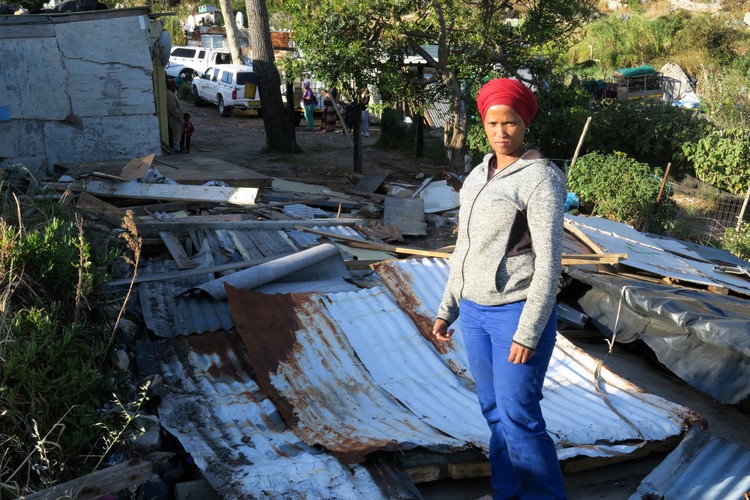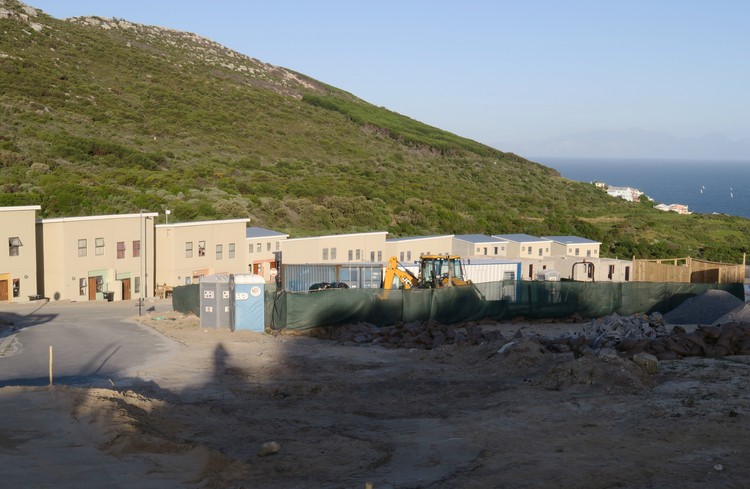New housing project in Simon’s Town leaves backyarders and tenants in limbo
Shacks are being demolished as families move from Redhill to new houses in Dido Valley
Sueann Duimpies stands in the ruins of the home she stayed in before it was demolished by the City on 8 November, when the owner moved to formal housing in Dido Valley. Duimpies said she and her two children have had to move into her father’s small shack in Redhill. Photo: Steve Kretzmann
- Families living in shacks in Redhill are being moved to new housing in Dido Valley near Simon’s Town in Cape Town.
- Their homes are being demolished as soon as they move.
- This leaves backyarders, tenants, and adult family members for whom there is no space in Dido Valley, facing homelessness.
Families living in shacks in Redhill informal settlement near Scarborough in Cape Town are being moved to new housing in Dido Valley, above Simon’s Town. But as the shacks are demolished, backyarders and tenants who have been living there fear they will be left homeless.
Of the 600 units in the Dido Valley housing project, 472 are reserved for Redhill residents, with 100 units set aside for families who were forcibly removed from Simon’s Town to Gugulethu during apartheid. The project was initiated in 2000, according to City of Cape Town human settlements mayco member Carl Pophaim, with the first keys handed over to Redhill families in May this year. Other families are moving as their houses are completed.
But as Redhill residents have pointed out, and Pophaim has confirmed, whenever a family from Redhill moves into their Dido Valley house, the electricity to their home in Redhill is disconnected and the structure demolished. This leaves any tenants, backyarders or family members who cannot be accommodated in Dido Valley, homeless.
Pophaim said Redhill, although established in 1974, is on private land and outside the urban edge and therefore cannot be properly serviced by the City. He said there are 468 “primary structures” in Redhill and the City intends to raze the settlement over time. He said backyarders and tenants were the responsibility of the “owners of the primary structures”. He said this was because the owners of the shacks, rather than the City, had given tenants or backyarders permission to move in or to build.
The Dido Valley housing project above Simon’s Town will house all 468 registered owners of primary structures in Redhill, as well as 100 families who were forcibly moved from Simon’s Town to Gugulethu during apartheid. Photo: Steve Kretzmann
But adult family members are also affected. Michelle Klein, 32, has three children aged between six and 13 and has been living in Redhill since she was about four years old. She is having to squeeze herself and her children into her mother’s two-bedroom house in Dido Valley after their Redhill home was demolished on 1 June this year. Klein, who works at a nursery just outside Scarborough, says she has no other options.
Melinda Overmeyer, who has three children aged between 18 months and 18 years, moved out of her mother’s house a year ago and rents a home in Redhill. The owner is to move to Dido Valley and she doesn’t know where she will live. Her mother and father moved to Dido Valley on 2 November, and the house she grew up in, with the extension her adult brother occupied, was destroyed. Overmeyer is afraid she’ll be in the same situation as her brother, who is now essentially homeless, sleeping on friends’ couches.
Lungile Nxayeka, who runs a garden service business, has for five years been living in a large shack with his partner and two children. He doesn’t know when its owner will take occupation of a Dido Valley house. Nxayeka says he has made numerous trips to the municipal offices in Ottery and the housing department in Plumstead to try and secure his family’s housing but has been told to “sort things out” with his landlord.
While GroundUp was interviewing Klein, Overmeyer and Nxayeka, about a dozen other Redhill residents gathered around, all with similar stories of their homes being demolished or about to be demolished. Some of them were backyarders, some were tenants, others were adults with young families who were not able to move to Dido Valley with their parents.
Lungile Nxayeka in front of his home in Redhill informal settlement. Nxayeka has been living in the house for five years but is unsure how long he’ll be able to stay there as it is due to be demolished as soon as the owner moves to Dido Valley. Photo: Steve Kretzmann
Pophaim did not say how many backyarders and tenants are affected in Redhill. But at a meeting between some of the residents and city housing officials last week – recorded by a resident – a City official can clearly be heard saying there were 200 backyarders in Redhill.
Pophaim said after the registered owners of shacks in Redhill who qualified for Breaking New Ground (BNG) housing had been moved to Dido Valley, attention would be given to owners of primary structures who did not qualify for the BNG programme. This could be because they had since found employment and earned more than the maximum R3,500 per month allowed in the BNG programme. It would be determined if they could qualify for a house in Dido Valley through other housing programmes such as FLISP (First Home Finance). Only thereafter would the City consider backyarders older than 30 for any remaining opportunities in Dido Valley. (According to a provincial directive, only people over 30 can be considered for housing.)
Klein, Overmeyer, Nxayeka and other Redhill residents said all they wanted from the City was temporary accommodation until the process had been completed.
Support independent journalism
Donate using Payfast

Don't miss out on the latest news
We respect your privacy, and promise we won't spam you.
Letters
© 2023 GroundUp. This article is licensed under a Creative Commons Attribution-NoDerivatives 4.0 International License.
You may republish this article, so long as you credit the authors and GroundUp, and do not change the text. Please include a link back to the original article.
We put an invisible pixel in the article so that we can count traffic to republishers. All analytics tools are solely on our servers. We do not give our logs to any third party. Logs are deleted after two weeks. We do not use any IP address identifying information except to count regional traffic. We are solely interested in counting hits, not tracking users. If you republish, please do not delete the invisible pixel.



